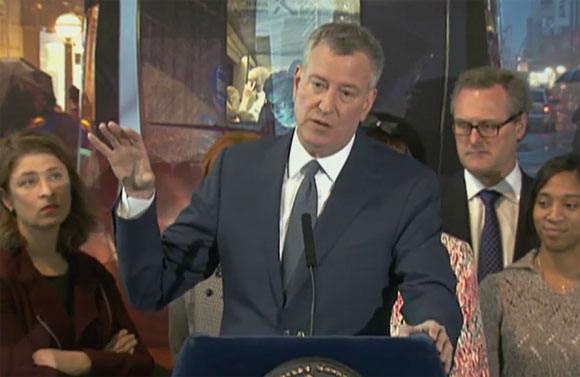
Today Mayor de Blasio rolled out the full court press for his Brooklyn-Queens Streetcar proposal, known as BQX. A story in the Times compared the street-running BQX to Jersey's Hudson-Bergen Light Rail, which runs mostly on exclusive rail rights-of-way. The City Hall press shop sent out waves of endorsements from various elected officials, advocates, business executives, developers, and civic honchos. The morning culminated with a press conference in Red Hook where the mayor made his case for the project.
The big takeaway is that City Hall has lined up a lot of people to endorse BQX. Specifics about the project itself remain in short supply. We don't know a whole lot more about the streetcar than we did before, and I remain skeptical that the project will be successful. It still seems likely to be a highly-subsidized, low ridership route for the reasons Streetsblog and others listed earlier this month.
The alignment doesn't create good connections to the subway, a free transfer to MTA services seems unlikely, the right-of-way will probably have significant stretches where cars will slow down and occasionally block trains, there are higher priorities throughout the city and better ways to serve people along the waterfront, and the financing mechanism depends on the streetcar spurring development in areas that are already booming.
We learned a few new things today but nothing that provided satisfactory answers to the major outstanding questions:
- The city's intent is for streetcar riders to get free transfers to subways and buses, but that's ultimately the MTA's decision, so it remains a question mark.
- Details about the alignment are not available. The stops would be spaced about every half mile, but the specific route has yet to be worked out, with public meetings starting this year.
- Details about financing are not available. The city's pitch is that the streetcar will cause property tax revenue to rise, which will fully fund construction. How will the city decide what increase in property value is attributable to the streetcar when so much of the waterfront is already growing rapidly?
- The city claims the streetcar will offer significant time savings compared to existing transit options (a 57-minute trip from Queensbridge to the Navy Yard will purportedly become a 27-minute streetcar trip), but it's hard to take these projections seriously in the absence of more specific information about where the route will run and how it will be separated from traffic.
- The city expects about two-thirds of the streetcar's operating costs to be covered by fares. Again, with so many variables unknown at this point, it's hard to take the estimate seriously.
At the press conference, Mayor de Blasio mostly referred to the project as "light rail," a term that implies the new route will have an exclusive right-of-way where it can't get bogged down in car traffic or easily blocked by an errant parked vehicle.
But Transportation Commissioner Polly Trottenberg called the project a "hybrid" between light rail and a mixed-traffic streetcar, with "as much as we can a right-of-way where we’ll be keeping traffic out, so that we can achieve speeds that are going to make the real travel times savings."
If traffic and parked cars aren't kept out of the streetcar right-of-way, one car left by the curb in the wrong spot will send delays rippling down the 16-mile route. To guarantee the streetcar can travel unimpeded, many streets along the route would have to either be stripped of parking or go entirely car-free. Claiming all that street space for transit would be thrilling -- but will it happen? At the press event, the mayor said the city will "be sensitive" to the loss of parking along the route.
More importantly, is it worth fighting so hard for a project that transit planners have never viewed as a high priority? A project that will almost certainly divert city resources from other improvements for streets and transit. An expensive streetcar with low ridership isn't the hill that transit advocates want to die on.





